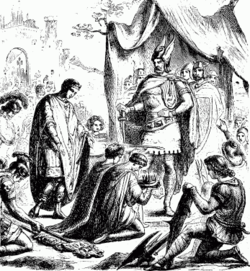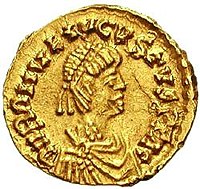Rome spent many years as a successful civilization, but this success diminished as a variety of factors wore the society down over time. Among these factors include religious and cultural shift in the division of the empire, poor leadership, and external attacks to the empire in its downfall. These factors can be represented respectively by the existing artifacts of the Roman Pantheon, The Sack of Rome by Joseph-Noël Sylvestre, and the tremissis of Romulus Augustus.
The Roman Pantheon started construction in 118 CE, originally built as a tribute to the gods in the Greco-Roman religion that was largely practiced at the time. This was built by emperor Hadrian in order to replace the previous Pantheon.(1) While we don’t know how it was exactly used, other than for general worship, the structure still holds up today. Despite its similar condition, the original purpose of the Pantheon was not what it was later used for, as religion and politics separated the empire greatly by the late third century, and the Pantheon ended up repurposed. As the Western half of the Roman Empire continued its old religious observance, the Eastern Roman Empire recognized Christianity as its official religion. After the Western empire fell and the Eastern empire became the Byzantine Empire, the Pantheon was changed from a Greco-Roman religious temple into a Catholic Christian church. This shows that the physical similarity of the Pantheon throughout its history is not necessarily indicative of its overall use and cultural impact. The switch from Roman mythological religion into Christianity represents how this element divided the two halves of the empire, thus portraying this important historical shift (and cause for the decline of the empire) in the context of a cultural icon such as the Pantheon. The Pantheon didn’t become a Christian institution for many years, instead gradually changing as the tides of culture and society shifted into the other religion. Division between halves of the empire was partially impacted by this religious shift, and this division was only one of many factors that led to the gradual fall of the empire.

Image of the Roman Pantheon from the front, circa 2006 (Dragan)
The empire, now divided into east and west, was essentially split into separate empires now, and they each faced their own problems: the west receiving the brunt of conflict due to a smaller military. Alaric was the king of the barbarian Visigoths at the turn of the fifth century, and began sieges on Rome in order to be able to settle around the area. Alaric, growing frustrated, tried to make one last compromise with the Romans, where Rome would integrate the Visigoths into the military and give them payments, but Emperor Honorius decided against this.(2) As a result, on August 24, 410 CE, rebellious slaves let the Visigoths into the city of Rome, where citizens were beaten, killed and raped. Most monuments and buildings were left standing, and many treasures survived since the Visigoths were also Christian and respected the property. After the three-day rampage was completed, the Visigoths left and went to settle in southwest France. This event very significant in the fall of the Roman Empire, since it allowed barbarian tribes the confidence to engage in conquests or sacks of Roman cities. This was one of the worst conflicts in the Roman Empire’s history, and was the beginning in unearthing what used to be a behemoth of an empire. This three-day conquest was a turning point for the Western half of the empire, as it declined by the end of the century. The artifact I chose to represent the sack of Rome is Joseph-Noël Sylvestre’s painting, The Sack of Rome by the Barbarians in 410. While this was painted over a millennium after the conflict, it, along with many other paintings of the event, portrays the conflict in a pivotal moment of history. I feel that the men stringing a noose around the statue’s neck and their “barbaric” nakedness is a solid metaphorical and literal representation of the decline of the Western empire to a point where a tribe like this could overtake them. The sack of Rome by the Visigoths was what set off a chain of events that led to the fall of the Western half of the empire.

The Sack of Rome by the Barbarians in 410 by Joseph-Noël Sylvestre (Public domain)
While the Eastern half of the empire continued on as the Byzantine Empire, the Western half fell after years of struggling under its counterpart and suffering from poor leadership. A prime example of the incompetent leadership of the Western Roman Empire is the last emperor: Romulus Augustus. Romulus was given the position of the emperor by his father, Orestes, when the previous emperor, Julius Nepos, was sent out. Orestes acted as the leader through his son, only giving Romulus the position of a figurehead who didn’t represent anything other than his father’s hunger for power.(3) After ten months of Romulus’s illegitimate rule of the Western Roman Empire, Odoacer, the leader of a Germanic tribe, stormed Rome in order to execute Orestes and remove Romulus from the position of Emperor in 476 CE.

A depiction of Romulus surrendering his crown to Odoacer (Public domain)
The tremissis, produced for every Roman emperor, is a gold coin that was created for currency and recognizing the power and rule of the emperor depicted.(4) The artifact that represents the incompetent ruling at the end of the Western empire’s history is Romulus’s tremissis. This factor in the fall of the Western empire occurred quite suddenly, as Romulus spent less than ten months in his position. This showed how far the Empire had fallen in terms of corruption, and change in how abruptly the chain of Western emperors stopped. While we still have coins depicting each emperor left today as artifacts, the political system of the empire was done away with later on, as the fall of the Western empire marked the start of the Middle Ages.

Romulus’s tremissis (Public domain)
Footnotes:
(1) “Roman Pantheon.” Rome.info. Accessed March 30, 2018. https://www.rome.info/pantheon/.
(2) Kerrigan, Michael. “Sack of Rome.” Encyclopædia Britannica. Last modified March 27, 2017. https://www.britannica.com/event/Sack-of-Rome-410.
(3) “On This Day In History: Emperor Romulus Augustus Deposed.” Ancient Pages. Last modified September 4, 2016. http://www.ancientpages.com/2016/09/04/on-this-day-in-history-emperor-romulus-augustus-deposed-on-september-4-476/.
(4) “Definition of Tremissis.” Merriam-Webster Dictionary. Accessed March 30, 2018. https://www.merriam-webster.com/dictionary/tremissis.
Bibliography:
“Definition of Tremissis.” Merriam-Webster Dictionary. Accessed March 30, 2018. https://www.merriam-webster.com/dictionary/tremissis.
Dragan, Roberta. “Pantheon (Rome) – Front.” Wikimedia Commons. 2006. https://en.wikipedia.org/wiki/File:Rome_Pantheon_front.jpg.
Kerrigan, Michael. “Sack of Rome.” Encyclopædia Britannica. Last modified March 27, 2017. https://www.britannica.com/event/Sack-of-Rome-410.
Mark, Joshua J. “Western Roman Empire.” Ancient History Encyclopedia. Last modified December 1, 2011. https://www.ancient.eu/Western_Roman_Empire/.
“On This Day In History: Emperor Romulus Augustus Deposed.” Ancient Pages. Last modified September 4, 2016. http://www.ancientpages.com/2016/09/04/on-this-day-in-history-emperor-romulus-augustus-deposed-on-september-4-476/.
“Roman Pantheon.” Rome.info. Accessed March 30, 2018. https://www.rome.info/pantheon/.






